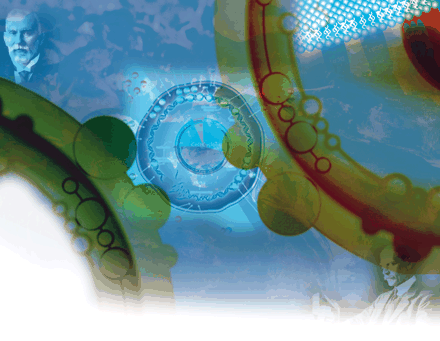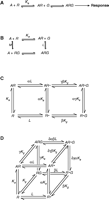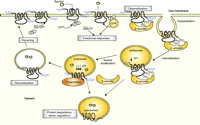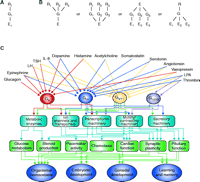The Receptor Concept: A Continuing Evolution
Abstract
This review briefly summarizes the development of the receptor concept, the identification of receptors based first on biological response data and subsequently on radioligand binding properties, and the biological and physiological understandings that these approaches have made possible. The development of receptor characterization began with receptors that ultimately were discovered to mediate response by coupling to G-binding proteins, also known as G protein–coupled receptors (GPCRs). Consequently, many if not all of the examples in this overview will describe studies characterizing GPCRs in general, and adrenergic receptors in particular. The purpose of this review, however, is not a detailed chronological account of a huge literature, but rather an overview of the fundamental questions posed and answered by these studies.
Evolution of the Receptor Concept
Specificity: A consequence of differential distribution or differential actions?
The first biological understanding of receptors was based on the findings of Paul Ehrlich (1854–1915), although the term “receptor” was not invoked at that time. Ehrlich was a pioneer in many fields, including toxicology, histochemistry, immunology, and chemotherapy (both antiparasitic and anticancer). The driving force behind all of Ehrlich’s research was determining the basis for selectivity of agents. His first studies examined the distribution of lead in the body, and led to the observation that lead was preferentially distributed into the brain. Thus, in at least one example, selectivity could be determined by the distributive properties of agents. Subsequently, Ehrlich applied this same conceptual framework of differential distributive properties to demonstrate that there was differential staining of tissues by dyes, staining that is referred to as “vital staining,” because the cells must be alive to maintain intracellular compartments that are either acidic or basic, permitting exploitation of staining of cells by acidophilic and basophilic dyes, respectively. Many of these findings on the distributive properties of dyes are still inherent today in histochemical characterization of tissue pathology.
Ehrlich’s studies revealed, however, that selectivity was not always accounted for by differential distribution into a particular cell, tissue, or organ, but rather could also be manifest by selective interactions with those entities. His notebooks show hand-draw-ings of “molecules” extending from cells, which serve as diagrams to explain his “side-chain theory” of immune response. Side chains could be recognized by the host organism as “foreign” and thus could lead to the elicitation of an immune response.
A second series of studies provided yet another example where selectivity in drug effect was because of selectivity in action rather than distribution. After observing the rapid motile behavior of parasites under the microscope, Ehrlich conceived the hypothesis that these highly motile agents were also very metabolically active and, as such, would be selectively responsive to poisoning by arsenicals as compared to the relative insensitivity of host tissues, presumably functioning at a lower metabolic activity. The validity of this hypothesis laid the groundwork for chemotherapy for antiparasitic and antimicrobial agents as well as for the basis of the chemotherapy for cancer treatment (1).
Ehrlich distilled all of his studies on selectivity into a single dictum: “Corpora non agunt nixi fixata,” meaning that agents can-not work unless they first bind. Despite the conceptual framework surrounding the selectivity of agents based on their interactive properties, Ehrlich never used the term “receptor.”
Ehrlich’s contemporary, J. N. Langley (1852–1926), introduced the term “receptive substance,” based on his findings that the mutual antagonism of two drugs on a tissue depends on the relative concentrations of drugs added, suggesting that drugs form complexes according to some law based on the relative concentrations and affinities of those drugs with a complexing agent in the target cell (2).
Despite the rigor of Ehrlich’s studies and the quantitative way in which Langley went about his examination of mutual antagonism of biological agents, not everyone accepted the receptor concept as a reasonable explanation for the basis of action of pharmacological agents. In fact, H. H. Dale (1875–1968) believed that the differential effectiveness of adrenaline analogs in mimicking sympathetic functions could arise from a chemical process, and did not necessarily imply the assistance of receptors on targeted tissues. Dale, thus, favored the distributive versus interactive properties of the drug in determining its target cell selectivity (3).
Receptors As Discrete Entities With Unique Specificities
In 1948, Raymond Ahlquist made a series of findings that were simply too hard to reconcile with the assertion that specificity of ligand action resulted solely from distributive properties. Ahlquist observed that epinephrine, norepinephrine, and isoproterenol elicited smooth muscle contraction vs relaxation with different orders of potency. The observation that smooth muscle contractions could be elicited by norepinephrine > epinephrine > isoproterenol was defined as the “α response,” and the ability of smooth muscles to be relaxed, or cardiac muscles contracted, by an order of potency of isoproterenol > epinephrine > norepinephrine was defined as the “β response” (4). Because circulating catecholamines are produced in and secreted from the adrenal, these two receptor populations came to be known as α- and β-adrenergic receptors (or “adrenoceptors”). Later, analogs of these catecholamines were developed which were found to have receptor-blocking effects, or served as antagonists at the receptor. The drug phentolamine blocked α-adrenergic receptors selectively, whereas the drug propranolol blocked the β-adrenergic receptor selectively, further corroborating the interpretation that distinct receptors for catecholamines exist (5).
In a manner analogous to Ahlquist’s conceptual framework, novel receptor populations began to be “defined” by the order of potency of agonists in eliciting one vs another response in target cells or tissues. Early investigators, however, appreciated that there was not necessarily a linear relationship between receptor occupancy and response, as had first been suggested by A. J. Clark (6). Instead, it became clear that there could be a differential efficiency of functional coupling between receptors and ultimate response, and this relationship between occupancy and response could be different for each agonist evaluated (7). This awareness revealed the limitation of defining receptors simply by the order of agonist occupancy in a single tissue. To learn the affinity of a receptor for an agonist unconfounded by amplification of the response, investigators created an artificial setting where a very high positive correlation existed between occupancy and response: by irreversibly inhibiting receptors using covalent antagonists to diminish functional receptor density to a point such that the maximum response to agonist was attenuated (8). Under these circumstances, the relative response to agonist correlated directly with the KD of the receptor for agonist (Kd is the concentration of a drug that occupies 50% of the receptors at equilibrium), such that the KD could be determined from the EC50 (i.e., median effective concentration, or the concentration that produces a response in 50% of subjects) of the biological response.
Receptors could be further characterized, and thus defined, by establishing the KD for antagonist agents in blocking agonist response (9–10). Competitive antagonists function by occupying the agonist-binding pocket and competing for agonist occupancy; these agents cause parallel rightward shifts in agonist-response curves when added in increasing concentrations in studies evaluating the concentration-response for agonist effects. Schild (10) demonstrated that replotting the raw data from these multiple agonist dose-response curves obtained in the absence and presence of antagonists, according to the equation referred to as the Schild regression, allowed estimates of the KD for the antagonist from the intercept of the plot. A slope of unity on a Schild regression provided additional insight that the antagonist was behaving as a competitive agent at a single set of receptors with a single, unchanging affinity for the antagonist drug.
Identification of Receptors Via Radioligand Binding Strategies
Implicit in the characterization of receptor interactions based on receptor-mediated response is the fact that a receptor molecule is one that both binds and acts, translating binding information to altered response in target cells. The classical pharmacological strategies outlined above infer the properties of receptor binding based on the receptor-evoked response. The advent of radiolabeled agents that retained their biological activity after iodination or tritiation allowed for the direct identification of biological receptors. The ease of receptor identification using radioligand binding when compared to detailed characterization of receptor-mediated functions led to an explosive growth of the literature on receptor characterization; however, the ease of the methodology did not excuse investigators from rigorous criteria for studying binding to functionally relevant receptors. These criteria included the expectation that: 1) the binding should be saturable, because there are a finite number of receptors; 2) the binding should manifest a selectivity in competing for radioligand binding that parallels the selectivity of those competing agents in modifying response; 3) the kinetics of binding should parallel the kinetics of response. When more details were known about selectivity of response, for example the stereoselectivity of adrenergic receptors, such that (l) or (−) isomers were more potent than (d) or (+) isomers in modifying response, additional criteria could be added to the expectations for radioligand binding that identified the functionally relevant receptor. More sophisticated understandings of receptor function also modified and extended these criteria, particularly for expectations regarding the kinetics of binding.
The first receptor that was directly identified by radioligand binding was the adrenocorticotropic hormone (ACTH) receptor, identified with iodinated ACTH (11). At adrenergic receptors, the use of antagonist ligands allowed for the unambiguous identification of these receptors. Earlier efforts at adrenergic receptor identification using radiolabeled catecholamine agonists revealed that there were multiple interacting sites for catecholamines not only on adrenergic receptors, but also on endogenous enzymes for catecholamine synthesis and degradation, which confounded adrenergic receptor identification (12). Also, the capacity for catecholamines to engage in oxidative chemistries limited their usefulness for receptor identification. Three laboratories virtually simultaneously demonstrated the suitability of radiolabeled antagonists for identification of β-adrenergic receptors (13–15). Soon thereafter, a variety of radiolabeled antagonists were developed for the identification of α1 -adrenergic receptors (15–18). A recent review describes in greater detail the history of the identification and characterization of adrenergic receptors and their interactions with critical regulatory proteins (19).
The Properties of Receptor-Agonist Vs Receptor-Antagonist Interactions
The direct identification of receptors with radiolabeled agents made it possible to address a myriad of questions about receptors: where they were expressed, how their expression changed during development, and how changes in receptor properties correlated with diseases. Being able to track receptors during receptor purification and reconstitution with signaling entities also permitted elucidation of the molecular units linking receptor binding to G-protein activation and, subsequently, effector modulation. However, the pervading question driving molecular and cellular studies of receptors in the late 1970s and early 1980s was: what do agonists do at receptors that antagonists do not, so that agonists, but not antagonists, provoke receptor-mediated signal transduction?
Earl Sutherland’s pioneering discovery of adenosine 3′, 5′ monophosphate (cyclic AMP, cAMP) as the second messenger of hormone action utilized by glucagon and catecholamines laid the groundwork for exploring receptor-mediated signal transduction. Sutherland demonstrated that cAMP was produced by an enzyme, adenylyl cyclase, from its substrate, adenosine triphosphate (ATP) (20–21), and that cAMP met multiple criteria expected for a “second messenger” inside cells of regulation of cell function by agents acting at the cell surface.
Sutherland and colleagues first hypothesized that hormones regulated the allosteric modulation of the enzyme at regulatory sites on the enzyme molecules (22). Two independent lines of experimentation, however, demonstrated unequivocally that β-adrenergic receptors and adenylyl cyclase are separable macro-molecules. In 1976, Orly and Schramm demonstrated that Sendai virus–mediated fusion of turkey erythrocytes, rendered β-adrenergic receptor-deficient by receptor inactivation using irreversible agents, with Friend erythroleukemia cells, which have no intrinsic β-adrenergic receptor-stimulated adenylyl cyclase response (23), resulted in fused cells manifesting isoproterenol-stimulated camp production. The ability to detect activation of turkey erythrocyte adenylyl cyclase by β-adrenergic receptors contributed from the fused Friend erythroleukemia cells implied the existence of distinct binding and catalytic entities. Findings demonstrating differential elution profiles of detergent-solubilized β-adrenergic receptor binding and adenylyl cyclase activity by size exclusion chromatography provided direct evidence that β-adrenergic receptors and adenylyl cyclase were separable molecules (24–25).
The inquiry into what agonists do differently from antagonists at receptors coupled to cAMP synthesis led to a series of discoveries implicating a GTP-binding protein in the signal transduction pathway. Martin Rodbell and colleagues demonstrated that agonists required GTP to activate adenylyl cyclase in isolated membranes (26). Biochemical (27) and genetic (28) strategies provided evidence that a separate GTP-binding protein was responsible for GTP activation of adenylyl cyclase (29). Cassel and Selinger demonstrated that agonists accelerate the activity of GTPase (30–31) and provoke GDP release (32), presumably from the GTP-binding site of the GTPase. These findings, together with a myriad of studies from other laboratories, led to the identification of a separate heterotrimeric GTP-binding protein (G protein) whose α subunit participates in a GTPase cycle that accompanies agonist stimulation of G protein–coupled receptors (GPCRs) (33). These functional interactions between receptors and GTP-binding proteins correspond to physical interactions between these two entities (34) and a now well-documented subunit cycle linked to the activation–deactivation of G proteins and their downstream signaling pathways (35). Taken together, studies of these functional interactions demonstrated that critical differences between receptor agonist and antagonist responses lie in their ability to promote, stabilize, or increase the probability of interactions between receptors and G proteins. These interactions of receptors with G proteins also were reflected by the ability of guanine nucleotides to regulate the affinity of agonist, but not antagonist, binding to GPCRs (36–38). Subsequently, the reciprocal regulation of negative antagonist, or inverse agonist, binding by GTP also was revealed [(38); see below].
The Receptor (Not The Ligand) Is Capable of Signaling
Early studies of insulin receptors and their role in different forms of diabetes led to the identification of insulin receptor–specific antisera in the circulation of some patients resistant to insulin. Many of these antibodies blocked receptor binding or activation, but some studies revealed the existence of antibodies that could activate the receptor chronically, ultimately leading to receptor downregulation––specifically, decreased expression of the receptor at the cell surface––and diminished sensitivity to insulin (39). The ability of an antibody to activate the insulin receptor, even in the absence of insulin, and evoke insulin-provoked signaling pathways provided evidence that the receptor, not the hormone, contained the “regulatory information” to modulate cell function.
Agonistic β1 -adrenergic receptor–specific antibodies promote idiopathic dilated cardiomyopathy in patients (40; reviewed in 41). These findings emphasize that the receptor “holds the regulatory switch,” and its activation or not, rather than the presence or absence of ligand, is the critical determinant for receptor-regulated signal transduction in acute and chronic regulatory settings.
Constitutive, or agonist-independent, activity of receptors, including GPCRs, also is indicative of the intrinsic regulatory activity inherent in the receptor structure. Several diseases have been attributed to constitutively active GPCRs (42). Intentional mutagenesis studies have revealed, however, that extremely subtle changes in GPCR structure can result in a continuum of agonist-independent activity, from zero (i.e., no basal stimulation of effector) to activity nearly indistinguishable from that maximally evoked by endogenous hormones or drugs (43). Teleologically, receptors with differing constitutive activity seem appropriate for mediating sensory inputs (where the basal signal must be zero, as in visual, olfactory, taste, or other perceptions) vs modulatory inputs, such as those that effect homeostatic mechanisms, where some “basal” tone might seem appropriate, even in the absence of a change in available hormone or neurotransmitter.
Molecular Models Describe And Provoke Experimental Findings
The profound difference between agonist vs antagonist interaction with receptors, especially with regard to regulation of binding by guanine nucleotides, led to the development of molecular models that were consistent with data obtained from antagonist–receptor binding studies and observations of agonist-evoked cellular changes. These models were invaluable, as they aided the design of discriminating experiments to test and refine proposed molecular models. Several models, such as the floating receptor model (44–45), the collision coupling model (46), and the ternary complex model (TCM) (47–48) emerged, but the TCM over the years has received the most experimental attention and amplification. As shown in Figure 1⇓, earlier versions of the TCM (48) were extended to create the expanded ternary complex model (ECM), which allows for the pre-coupling of receptors to G proteins and constitutive receptor activity and explains the properties of inverse antagonists (49). Inverse agonists (or reverse antagonists) are agents that interact with the receptor and stabilize the inactive form of the receptor. This property is manifest by a decrease in the “basal,” or agonist-independent, activity of receptors arising from some intrinsic (or constitutive) activity in eliciting a response. Inverse agonists also demonstrate leftward shifts in competition profiles when evaluated in the presence of guanine nucleotides (38).
Evolution of models describing the coupling of GPCRs to G proteins. A. The earliest models of signaling evoked by GPCRs were linear, with a single receptor, upon agonist occupancy, binding to and activating a G protein, which then activated a downstream signaling pathway. B. The Ternary Complex Model (TCM); (47–48) described a relationship between receptor affinity for agonist (Ka) and receptor affinity for G (Kg), the G protein, both regulated by GTP. C. The Extended Ternary Complex Model (ECM) (49) allows for the receptor to spontaneously isomerize to an active state, R*, or to couple to G in the absence of ligand. The cooperativity factors (e.g., α, β) modify the isomerization constant, L, as well as the equilibrium association constants (Ka and Kg ) when these isomerizations occur for receptor occupied either by agonist or inverse agonist. D. The Cubic Ternary Complex Model (50), allows for the existence of inactive ARG complexes. Another cubic model (51) allows for active and inactive receptor states with no G protein coupling, and can be adapted for modeling allosteric modulation of GPCRs by small molecules, rather than by interaction with G proteins (52). Panel B modified from (48) and panels C and D modified from (52).
These models continued to evolve to incorporate additional biological findings, leading, for example, to recent extension of the ECM to cubic models. The example given in Figure 1D⇑, can explain systems where the Agonist-R•G complex is biologically inactive, as has been observed in some experimental settings (50). A separate cubic model describing active and inactive states with no G-protein coupling (51) is relevant for allosteric regulation of GPCRs by sites or molecules other than separate GTP-bind-ing proteins (52). Overall, increased molecular understandings of GPCR properties and their relationships to downstream regulatory models has led to a renaissance in receptor theory and new quantitative studies of receptor biology and pharmacology (53).
Agonists, Antagonists, And Partial Agonists: Differences In Their Receptor Interactions
The increased complexity of models describing the properties of GPCRs and their interactions with GTP-binding proteins, necessary to account for experimental findings describing the properties of agonists, profoundly altered our understanding of agonists and especially of partial agonists. Earlier conceptualizations of GPCRs suggested that the receptor could exist in an inactive or an active state (often denoted R and R*). These perceptions, as described by two-state models, anticipated a single agonist-induced or active receptor conformation that effectively transduced a signal to its cognate G protein or effector system. Partial agonists were interpreted to evoke this same conformation, but less frequently (i.e., bind to and/or stabilize R* with lower affinity). Yet, it is clear that multiple active receptor conformations exist and are uniquely evoked by different agonists. This is revealed both in cellular systems, where converse agonist profiles are observed for a single receptor’s activation of multiple signaling pathways (54), as well as in the analysis of purified receptor systems. Thus, fluorescent spectroscopic studies of ligand-induced conformational changes in the G protein–coupling domain of the β2 -adrenergic receptor have revealed that conformations induced by a full agonist can be distinguished from those induced by partial agonists (55–56). Newer models have not only been proposed that predict multiple, agonist- specific states of the receptor but also an activation of down-stream events that occurs through a sequence of conformational changes (57–60). Although these models, developed to reconcile biological findings, may add complexity to our understanding of physiological and pharmacological phenomena, they also forge the theoretical groundwork for the development of pathway-specific therapeutic agents (61).
Receptor-Mediated Desensitization
The dynamic changes in receptor properties that accompany changes in receptor function, such as desensitization, provided a lens into the molecular events that regulate the sensitivity of GPCR signaling pathways. Early studies by Lefkowitz (62) and Perkins (63–64) and colleagues revealed that multiple, partial reactions contribute to loss or attenuation of receptor function. Subsequent findings from a number of laboratories have elaborated the molecular detail inherent in receptor-mediated desensitization pathways, in particular, for homologous desensitization, which occurs when an agent activates a GPCR and leads to desensitization of that receptor and its signaling properties alone, without “cross-talk” or crossover with other GPCRs sharing the same signaling pathway. A paradigm has been developed from studies of β-adrenergic receptors for GPCR desensitization, endocytosis, and recycling or degradation (Figure 2⇓) (65–70).
Agonist-evoked redistribution of GPCRs. Agonist occupancy of the receptor leads to GRK-catalyzed phosphorylation, binding of arrestin, and entry into the cell via clathrin-coated pits. Receptors can either be degraded or, post-dephosphorylation, recycled to again be activated by agonist. Figure from (70). Published with permission from Elsevier Press © 1999.
The characterization of receptor structure has permitted a better under-standing of the dynamic changes in function that occur during a receptor’s lifecycle. In 1981, the β2 -adrenergic receptor was isolated and purified from the frog erythrocyte (71) followed by the purification of the turkey erythrocyte b1-adrenergic receptor (72) and the mammalian β2 -adrenergic receptor (73–74). The purification of the receptor provided the starting material for amino-acid sequencing of proteolytic fragments of the receptor, ultimately leading to the cloning of the β-adrenergic receptor. In a land-mark publication (75), the predicted topography of the cloned β-adrenergic receptor was shown to resemble that of rhodopsin, a seven trans-membrane- spanning receptor. A subsequent flurry of studies exploiting these molecular cloning strategies and implementing intentional mutagenesis and the use of receptor chimeras (76–77) permitted the assignment of functional regions within the GPCR family (Figure 3⇓).
Generic diagram of sequence regions involved in post-translational modification and modulation of functions. Summary of findings based on receptor mutagenesis and construction of receptor chimeras for a variety of GPCR.
Molecular cloning also allowed for the concrete identification of receptor subtypes and their ligand selectivity. For example, the β-adrenergic receptor family is now known to be composed of three members––the β1 , β2, and β3 adrenergic receptor subtypes–– all encoded by distinct genes on different chromosomes. Similarly, α-adrenergic receptors could be classified as α1 - or α2 -adrenergic receptor subtypes. This classification superseded previous physiological characterizations of α2-adrenergic receptors as presynaptic (α2) and postsynaptic (α1) (78), and provided the molecular tools for examining the role of these subtypes in different functions. Gene targeting and transgenic studies, made possible by prior molecular cloning of receptors, have delineated the in vivo roles of different receptor subtypes (79–81).
The Role Of Receptors In Disease
Molecular cloning and sequence verification also provided the basis for assigning the molecular correlates of disease. The underlying assumption in these studies is that biological response is a function of the number of agonist–receptor complexes (i.e., occupancy theory), the amount of effectors, and the efficiency of receptor- effector interactions (i.e. response = f [Agonist • R][effector]). The amount of agonist–receptor complex, of course, depends on the amount of agonist and receptor available for this interaction. Classic endocrinology focused on diseases caused by alterations in availability of “agonist” (i.e., hormones). Molecular insights into receptor signaling have expanded the hypotheses regarding the origin of disease, including changes in receptor concentration, the affinity of the receptor for agonist, efficiency of receptor-effector coupling, or structure of any of the entities involved in receptor signaling due, for example, to polymorphisms in the genes that encode them. The ultimate goal of any study into the molecular basis of disease is to learn the causal relationship between genotype and phenotype, and how post-transcriptional and post-translational modulations also contribute to pathology.
Signaling Networks
Increasingly sophisticated characterization of receptors has been accompanied by increased understanding of the molecular underpinnings and regulation of G proteins and their effector pathways, as demonstrated in Figure 4⇓. The earliest perceptions of G protein–mediated signaling conceived a linear pathway linking a single receptor with a single G protein, referred to as the cognate G protein, which was coupled to an effector characteristic of that receptor (Figure 4A⇓). A plethora of functional studies have demonstrated, however, that there is likely a stochastic interaction between receptors and G proteins and effects, (Figure 4B⇓) (80). In fact, the concept of signaling networks (Figure 4C⇓) has not only been proposed but clearly demonstrated in a variety of cases (83–84). These findings remind us that subtle changes in receptor structure––for example, as encoded by genetic polymorphisms–– can have profound consequences in receptor-coupled signaling pathways and, via altered crosstalk, profound pleiotropic changes in cellular function.
Evolution of the complexity of our perception of GPCR-mediated signaling from a pathway (A) to matrices (B) to networks (C). Receptors (R) interact with one or more G proteins (G) linked to one or more effectors (E), which then engage in effector cross-talk and regulation of cellular function at the surface membrane, within the cytosol, and among multiple cellular compartments, including the nucleus. Panels A and B are modified from (82) (Permission granted by CellPress © 1989) and Panel C from (84) (Permission granted by AAAS © 2002).
A variety of additional players have been identified that contribute to the networks of GPCR-mediated signaling such as AGS (activators of G-protein signaling) proteins, which change the efficiency of coupling between receptors and G proteins (85), and RGS (regulators of G-protein signaling) proteins, which do the same for the interactions between effectors and G proteins (86). In addition, the number of molecules complexed, transiently or constitutively, with GPCRs is forever expanding. In fact, GPCRs themselves may interact with other GPCRs. An expanding literature has shown the role of homo- and hetero-oligomers in creating viable receptors [e.g., γ-amino butyric acid (GABA) receptors] (87) and receptors with modulated ligand specificity (88). Interaction of GPCRs with structurally distinct subunits––for example, binding to receptor activity-modifying proteins (RAMPs)––can confer variable selectivity in GPCR complexes for endogenous ligands (89). Similarly, arrestin, first discovered as a molecule involved in signal termination in the visual system and subsequently in all GPCR signaling systems, is an adaptor protein that allows interaction with subunits of the endocytosis machinery gathered at clathrin- coated pits, thus mediating internalization, as well as serving as a scaffold for other signal inputs, such as mitogen-activated protein kinase (MAPK) (90). Other proteins are also emerging as important for defining receptor signaling pathways: spinophilin, an endogenous antagonist of multiple arrestin functions (91), and ezrin-binding phosphoprotein-50/Na+ -H+ Exchanger Regulatory Factor 1 (EBP-50/NHERF1), might participate in defining postendocytic fates of receptors (92–94). Other proteins have been implicated in linking GPCRs to different cytoskeletal elements or other regulatory molecules within the cytosol (95). Overall, this expanding repertoire of molecules that mediate or modulate GPCR-mediated signaling heightens our awareness of a well coordinated, but intrinsically complex, cellular network regulated by GPCRs.
Future Perspectives
As with receptor diversity and signaling networks, the scope of the biomedical research enterprise also has become broader and deeper. Hypothesis-driven research focusing on one or a limited number of molecules has expanded to exploit unbiased genome-wide data gathering, thereby revealing the unsuspected breadth of the molecules impinging on, or downstream of, signaling path-ways. Such inquiries permit the subsequent generation of novel and previously non-intuitive hypotheses that can be tested in more molecular detail by evolving methodologies, including those that examine single molecules or cells in their native environment in real time. It is clear that the remarkable acceleration of new knowledge that has occurred in the last thirty years will not diminish. This acceleration also means that, within an individual’s own career-span, an investigator will be able to navigate among molecular, cellular, and in vivo inquiries to solve questions of fundamental biological importance. Such an accelerated culture of research has profound implications for discovery, its translation into societal benefit, the lifetime training of career investigators, and society’s commitment to supporting this enterprise.
Acknowledgments
The author is grateful to Drs. Robert J. Lefkowitz (Duke University) and Terry P. Kenakin (GlaxoSmith Kline) for their constructive review of the manuscript. She also is grateful for the comprehensive understanding of receptor theory and receptor signaling shared with her directly by Dr. Joel G. Hardman (Vanderbilt University) and indirectly by Dr. Jesse Roth (when at NIDDK, NIH) over the years of her training and during her maturation as an investigator at Vanderbilt University, as well as to a large number of wonderful collaborators, whose insights permitted her continual education, particularly Dr. Brian Kobilka (Stanford).
- © American Society for Pharmacology and Experimental Theraputics 2004
References

Lee E. Limbird, PhD, is on sabbatical from Vanderbilt University, where she served on the faculty of the Department of Pharmacology since 1979, chaired the Department from 1991–1998 and then served as the first Associate Vice Chancellor for Research at Vanderibilt University Medical Center until the close of 2003. Her postdoctoral research with Robert J. Lefkowitz at Duke University (1973–1979) and subsequent involvement in the teaching of receptor theory with Joel Hardman at Vanderbilt gave her a unique opportunity to learn from the classical contributions of those who interrogated drug action in in vivo systems. She also has gained knowledge from personal glimpses of the evolution of the concept of a receptor as a discrete macromolecule that could be lured from the membrane with biological detergents and evaluated functionally either as an individual molecule or as a result of interactions of added regulatory molecules, such as G proteins and small-molecule ligands. E-mail lee.limbird{at}vanderbilt.edu; fax 615-356-5722.








